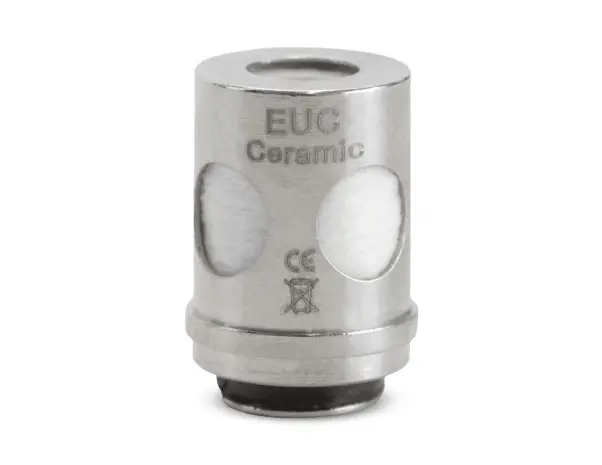
Vape coils with ceramic wicks have been available for several years. During that time, ceramic wicks have never really progressed beyond niche status in terms of their popularity. While ceramic as a wick material for vaping has never enjoyed anywhere near the popularity of cotton, it does have plenty of devoted fans who wouldn’t want to use any other type of wick – which means there definitely must be situations in which using a ceramic wick makes perfect sense.
So, what’s the deal with ceramic vape wicks? How do they work, and what are the reasons why some people use them? Most importantly, is a ceramic wick viable for sub-ohm vaping? Let’s dig in.
How Do Ceramic Vape Wicks Work?
If the idea of a vape wick made from ceramic sounds odd to you, it’s probably because you’ve never really thought of ceramic as an absorbent material. If you pour water on a ceramic plate, for instance, it doesn’t soak in – it beads and rolls off.
It is actually possible, however, to take thin fibres of spun ceramic and weave those fibres into textiles that resemble blankets or pads. Those pads do, in fact, absorb liquid just like a natural fibre pad would. That property makes it possible to construct a vape coil with a ceramic wick by wrapping a ceramic pad – rather than the traditional cotton pad – around the coil.
Another form of ceramic wick is made from liquid ceramic that’s poured into a mould, dried and fired just like traditional ceramic pottery. The difference, though, is that when ceramic is used to make a hard wick, organic substances are added to the liquid ceramic mixture. After it’s dried, the ceramic wick is fired at an extremely high temperature. The organic material burns away, leaving a hard ceramic wick with a network of tiny holes. The holes make the ceramic porous and allow liquid to pass through it.
Ceramic textile is the most popular form of ceramic for e-liquid vaping, but hard ceramic wicks have a useful application that we’ll discuss in a moment.
What Are the Benefits of Ceramic Vape Wicks?
To fully understand what a ceramic wick can do to benefit your vaping experience, you must first consider the drawbacks of what you’re currently using. What is the biggest drawback of cotton as a material for vape wicks? It must be the fact that cotton burns easily. If you’re using a coil with a cotton wick and don’t prime the coil properly before installing it, the wick can burn. If you forget to refill the tank, the wick can burn. If you set your vaping wattage too high – well, you get the idea.
Ceramic, on the other hand, can get as hot as around 2,000 degrees Celsius before it begins to melt. It is virtually impossible for the heat of a vaping coil to burn a ceramic wick – so heat resistance is a major benefit.
Another benefit of ceramic as a wick material for vaping is that it should be completely inert and shouldn’t react with the e-liquid in any way. Some people find, therefore, that a ceramic wick tends to offer a purer flavour than a cotton wick. Taste is subjective, of course, and that means your opinion may differ. When ceramic coils reached the peak of their popularity in the mid-2010s, though, the manufacturers often marketed them as “flavour chasers’ coils.”
Ceramic wicks also offer an additional benefit in that they tend to work much better than cotton with extremely thick substances like CBD oils. Hard, porous ceramic wicks tend to work particularly well with thick liquids. So, while ceramic wicks may not be particularly popular for e-liquid vaping – you’ll learn the reasons for that shortly – they are quite popular among CBD aficionados.
What Are the Drawbacks of Ceramic Vape Wicks?
Ceramic has one major drawback as a wick material for vaping, and it’s the fact that ceramic doesn’t transport liquid as efficiently as cotton does.
When you use a vape tank with a cotton wick, you’ve probably noticed that bubbles begin to rise to the surface of the tank’s reservoir almost as soon as you release your mod’s fire button after puffing. Those bubbles indicate that your coil’s cotton wick is absorbing more e-liquid from the reservoir. After just a couple of seconds, the tank is ready to use again.
That’s not the experience you’ll have with a ceramic wick. When you use a tank with a ceramic wick, you’ll need to wait several seconds after each puff for the wick to absorb more e-liquid before the tank will be ready to use again – and that’s true even if you’re using a relatively high-resistance coil that doesn’t produce enormous clouds.
So, ceramic wicks do work for sub-ohm vaping, but they’re going to give you a very different experience from what you might be used to because you’ll need to wait much longer between puffs for the wick to absorb more e-liquid. If you don’t wait long enough, you’ll get dry hits.
Final Thoughts: Should You Use a Coil With a Ceramic Wick?
While ceramic wicks are definitely viable for sub-ohm vaping, using a coil with a ceramic wick may mean that you’ll need to lower your expectations a bit with regards to cloud production. The reason why virtually all of today’s sub-ohm tanks use coils with cotton wicks is because cotton is a very efficient carrier of liquid. Even if you’re using an extremely powerful mesh coil, a cotton wick will have no trouble keeping up with the coil’s demands as long as you wait a few seconds for the wick to get wet again after each puff.
Ceramic, on the other hand, transports e-liquid so much more slowly than cotton that it may not work at all as a wick material for a high-end coil. As long as you’re not trying to chase enormous clouds, though, you may be very happy with a coil that uses a ceramic wick – especially if you find that a ceramic wick produces a purer flavour. If you stick with coil-friendly e-liquids and avoid sweetened vape juices, you’ll probably also find that using a ceramic wick helps your coils last much longer.
